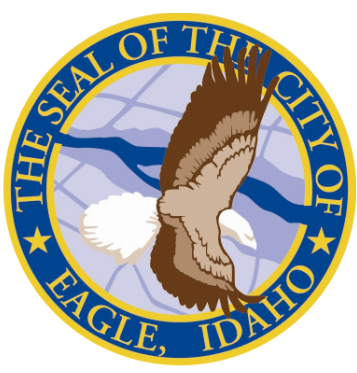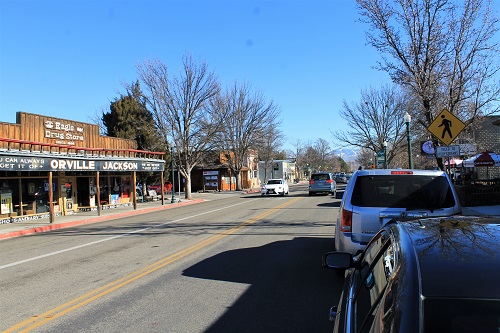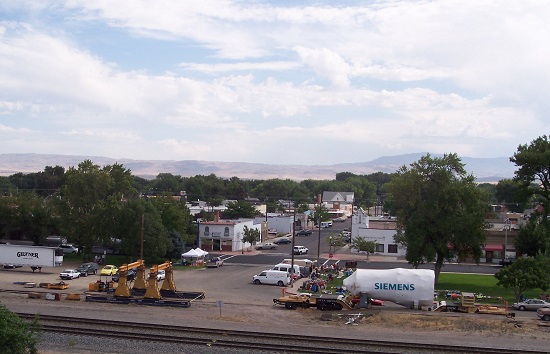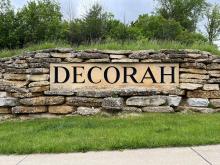
Inspired by Ammon, Idaho’s heralded open-access fiber network, the city of Eagle, located in the southwestern part of the state and home to 32,000 residents, is now soaring ahead with building its own open-access fiber network to connect city facilities and bring quality broadband to residents and businesses.
Eagle’s low density makes it expensive to connect, and as a result, the city has suffered from a lack of investment from private broadband providers. This has left residents – many of whom work from home or homeschool their children – with limited and antiquated options. But Eagle Mayor Jason Pierce wasn’t ready to hand over the city’s connectivity future to the big incumbents.
He explained to ILSR how Ammon’s “successful model” was the inspiration for Eagle and other cities across the Gem State to embark on a mission to provide city-wide connectivity and competition in areas underserved by the big incumbents.
“Cities were using [American Rescue Plan Act] ARPA dollars to help supplement […] private companies. We didn’t think that was the proper way to [go]. Federal dollars are the people’s money, they should own whatever we use it for. We need to be going after [public funding] to get [our residents’] tax dollars back into our communities.”
The open access network will give small local providers a chance to go into areas that it would not have previously made financial sense for them to serve. With the infrastructure already in place though, these companies will be able to enter the market and offer competition.

Eagle’s plan is to first deploy fiber to the city’s downtown area, even as Eagle officials acknowledge that permitting has been a challenge. And that’s primarily because Eagle is one of the few, and possibly the only city in the country, where the roads are controlled by the county rather than the municipal government.
Creative Approach to Financing
Pending this final approval from the city, like Mountain Home, Eagle city leaders are using Covid relief funds to “jump-start” the project with plans to allocate $5 million of its $6.5 million in Rescue Plan funds to build out a fiber backbone to downtown premises. From there, they will look to connect city facilities like parks, water pump houses, and sprinkler boxes.
To supplement the federal funding, Eagle is taking a creative approach, looping in the city’s fire district, which reaches beyond city limits and qualifies for other government funding that is not available directly to the city itself. The plan is to run fiber to the firehouses, and then seek funds to connect them to each other. The same goes for the sewer system – it is eligible for public funding that is not directly accessible to the city of Eagle. These entities can go after funds, then Eagle can help them run fiber among facilities. City leaders say its a strategic approach that will bring down the fiber costs per mile, lightening the load for taxpayers.
Eagle’s schools are also part of a larger district, which led the city to coordinate with the broadband provider the school district uses. While that company runs conduit to connect the schools, they will also oversee Eagle’s conduit system, which will reduce multiple street disruptions. While the schools do not own their own fiber, Mayor Pierce hopes when the district’s contract is up in about 15 years, the city of Eagle can run its own fiber to the five schools within its jurisdiction and support any future connectivity needs between schools.

As Eagle builds out to its municipal facilities, it will also connect residents and businesses along the way. Upcoming residential build outs will be determined based on the results of a survey currently posted on the city’s website that assesses broadband demand within the community.
To finance network costs that are not covered by public funding, Eagle plans to use a residential cost model similar to Ammon’s, where subscribers pay for installation and maintenance of the infrastructure in addition to Internet service.
In Ammon, subscribers have the option to pay the cost of installation (about $3,500) upfront, or to attach the financing of this installation cost to their property over 20 years. All three cost components come out to around $55 per month for subscribers – assuming they select the installation financing option, which most do.
Eagle’s pricing breakdown has not yet been solidified, but residential prices are estimated to level out at about $50/month for a symmetrical gig.
Though just getting started, Eagle is aiming to connect all of its residents. Over the past decade, the city has added an average of 1,000 new homes each year to its housing stock, which Mayor Pierce considers a great opportunity to grow and sustain the network. The city also hopes to interconnect its local network with a larger county-wide fiber network that Mayor Pierce hopes will eventually exist.
Mountain Home Completes Fiber Backbone and Prepares to Connect Residents
Meanwhile, about an hour southeast of Eagle, the city of Mountain Home (population 14,000), is making progress on its own fiber network. The inspiration Mountain Home drew from Ammon came when Mountain Home Mayor Rich Sykes visited Ammon’s network when he took office in 2015. Up to that point he had considered broadband as a private sector issue. But after seeing what Ammon was doing, and inspired by Mountain Home citizens pleading for the town to “fix the Internet,” the visit proved to be a real eye-opener.
“I went down to Ammon to check it out, but I was a skeptic. Once I saw what they were able to do to help their citizens, it was a no-brainer,” he said.

Mayor Sykes returned excited about investing in Mountain Home’s broadband future and became a champion for a municipal, open access project in Mountain Home. So far, over 14 miles of fiber backbone has been deployed. The city is now preparing to start connecting homes in its first local improvement district (LID), which includes four neighborhoods. Construction for the second LID will be based on demand. And, thanks to a new ordinance that requires developers to install conduit to each new home, Mountain Home has already brought service to 40 newly-constructed homes outside of the first LID.
Although the network is not fully built-out, already the city has four Internet service providers (ISPs) using the network. Each of those ISPs are local and independently-owned, which hasn’t gone unnoticed or unappreciated by local residents.
“Those 40 homes could have hooked up to the conventional ISPs and they said no, because the speeds and customer service was horrible,” Mountain Home Mayor Rich Sykes told ILSR. One customer reported a one-to-two month wait time for one of the larger ISPs, then chose to go with Mountain Home fiber and was connected within a day.
Sykes also spoke to the importance of marketing to make sure residents were aware of the options they now had. Before construction began in the first neighborhood, Mayor Sykes said town staff walked from door to door, distributing fliers, answering questions, and providing a QR code for folks to sign up for the service. The next day, they saw 30 new signups in that neighborhood.
It’s a small start, in a small city. But the Mayor has a big vision. “I want Mountain Home to be a next century city. I wanted to make sure that [we are] not just competitive in the local market when it comes to businesses, but in a global market,” Mayor Sykes said.
Emmett Launches a Fiber Pilot With Plans for Expansion
Nearby Emmett, Idaho (population 6,500) is among the farthest along on its own open access fiber network, with all of its municipal facilities already connected, including its city hall, library, police station, fire house, 911 centers, cemetery, and water and wastewater facilities.
Before the network, Knittel shared, each city facility had a different contract with a different provider. “Things were disparate. We weren’t sharing any kind of resources we could have if we had that interconnection between [facilities],” he said.

The city already has four Idaho-based ISPs offering service, and also offers its own service in competition with these private providers. The city’s price model is very similar to Ammon’s, with customers paying both infrastructure and service payments.
Emmett’s own ISP, Emmett Fiber, offers service at $70/month for one gigabit, but does not intend to undercut the private providers on the network. The goal is to provide the community with a particularly responsive and locally-accountable option for Internet service, Emmett IT Director Mike Knittel said.
So far, Emmett has connected eight homes and two businesses as part of a fiber pilot in a newly-constructed residential subdivision. The city plans to expand into a larger, 200-home subdivision that will soon be completed across the street. Though developers are not required to run conduit or fiber to new homes like they are in Mountain Home and Eagle, they do have to pay the city a fiber fee attached to the building permit.
Emmett hopes to eventually bring service to the whole community, but the city is also in communication with other cities doing the same work across Idaho. Knittel mentioned an upcoming project will take fiber through both Emmett and Eagle. He said that the city is, “very active and stay[s] in touch with other entities who are doing [fiber] in our state.”
Ammon’s Foundational Open Access Fiber Model
Ammon’s open access network has inspired these networks, as well as others nationwide, but the fundamental motivation behind the Ammon network was to serve all 20,300 of the city’s residents. “Incumbent operators want to serve just enough to make the maximum profit, and cities are incentivized to build networks which profit just enough to provide the maximum service,” said Jeff Christensen, President of EntryPoint Networks, the consultancy that worked with Ammon to build its network.
Though the city of Ammon did contribute funds to the network, the cost model that it leveraged (dividing the debt among households that opt in) allows a municipality to provide affordable, quality, and future-proof connectivity to its residents without taking on municipal debt.
By breaking up service and infrastructure, Christensen said, it's possible to disrupt large incumbent control and create a network better designed to serve subscribers. “We’re thinking both long term and short term and trying to get cities to invest in strategy. [We’re asking cities]: are you comfortable outsourcing your digital future to a large incumbent and letting them set what’s possible for you?” he asked.
Stay tuned for further updates from communities embarking on open access fiber projects, across the state of Idaho and beyond.
See informational videos on Ammon below:
Header image Eagle, Idaho sign over street courtesy of Wikimedia Commons, Attribution-ShareAlike 4.0 International (CC BY-SA 4.0)
Inline image of downtown Eagle courtesy of Wikimedia Commons, Attribution-ShareAlike 4.0 International (CC BY-SA 4.0)
Inline image of Mountain Home, Idaho courtesy of Wikimedia Commons, Attribution 2.5 Generic (CC BY 2.5)
Inline image of Eddy's Bread in Emmett, Idaho courtesy of Wikimedia Commons, Attribution-ShareAlike 4.0 International (CC BY-SA 4.0)







